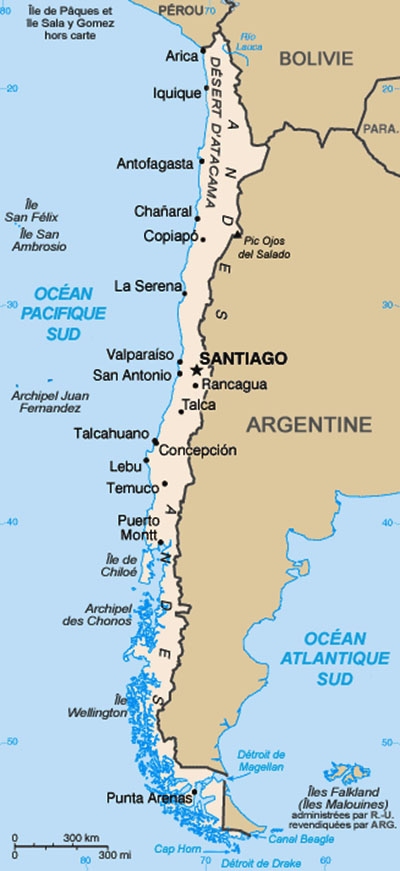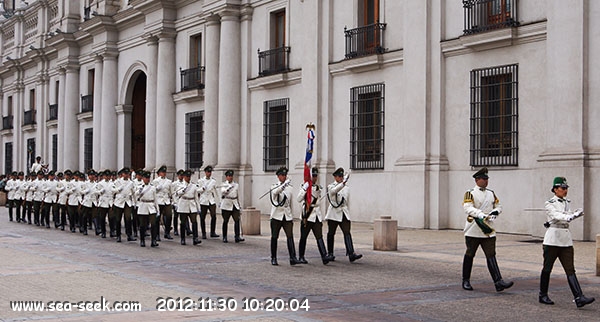
From Arica to Punta Lengua de Vaca (N Chile)
Almost the entire length of the coast is invaded by a desert. The Andes Cordillera advances to the seaand gives a very high and steep coast. There are many natural harbors ...
| Latitude | Longitude | |
| DMS | --- | --- |
| DM | --- | --- |
| DD | --- | --- |

 Chile, on the Pacific coast of S America, is defined by Peru at N, Bolivia at NE and Argentina at E. It extends over 4,300 km long, from Peru to Cape Horn, and 175 km wide on average (350 km to the level of Antofagasta and to the Tropic of Capricorn, 15 km in the southernmost at Puerto Natales) .
Chile, on the Pacific coast of S America, is defined by Peru at N, Bolivia at NE and Argentina at E. It extends over 4,300 km long, from Peru to Cape Horn, and 175 km wide on average (350 km to the level of Antofagasta and to the Tropic of Capricorn, 15 km in the southernmost at Puerto Natales) .Chile also has the Juan Fernández Islands, Easter Island (or Rapa Nui) and Sala y Gómez Island, all located in the South Pacific, but Easter Island is the farthest from the coast of Chile, it is to 3700 km, while it is geographically part of Polynesia.
Several archipelagos (Chonos, Wellington Island and the western part of Tierra del Fuego) along the southern coast of Chile from Chiloé Island to Cape Horn.

 Le Chili, sur la côte pacifique de l'Amérique du S, est délimité par le Pérou au N, la Bolivie au NE et l'Argentine à l'E. Il s'étend sur 4 300 km de long, du Pérou au cap Horn,et 175 km de large en moyenne (350 km à la hauteur d’Antofagasta et du Tropique du Capricorne, 15 km dans l’extrême sud à Puerto Natales).
Le Chili, sur la côte pacifique de l'Amérique du S, est délimité par le Pérou au N, la Bolivie au NE et l'Argentine à l'E. Il s'étend sur 4 300 km de long, du Pérou au cap Horn,et 175 km de large en moyenne (350 km à la hauteur d’Antofagasta et du Tropique du Capricorne, 15 km dans l’extrême sud à Puerto Natales).Le Chili possède aussi les îles Juan
Fernández, l'île de Pâques (ou Rapa Nui) et l'île Sala et Gómez, toutes situées dans le
Pacifique-Sud, mais l'île de Pâques est la plus éloignée des côtes chiliennes,
soit à 3700 km, alors qu'elle fait partie géographiquement de la Polynésie.
Plusieurs
archipels (Chonos, île Wellington et le secteur occidental de la Terre
de Feu) longent le littoral méridional chilien depuis l'île Chiloé
jusqu'au cap Horn.
Le territoire chilien de l'Antarctique (1 250 000 km²) est situé au S du 65ème parallèle S.
Administrativement, le Chili est découpé en
15
régions: Tarapacá, Antofagasta,
Atacama, Coquimbo, Valparaíso, Libertador General Bernardo O’Higgins, Maule,
Bío-Bío, La Araucanía, Los Lagos, Aysén del General Carlos Ibáñez del
Campo, Magallanes y de la Antártica Chilena, Región Metropolitana de Santiago.
La capitale du Chili est Santiago.
Le pays se situe dans une zone fortement sismique et volcanique : cette activité découle de la poussée de la plaque tectonique de Nazca sous la plaque sud-américaine supportant le continent. Le pays fait partie de la ceinture de feu du Pacifique.
Le pays est composé principalement d’une zone de plaines encadrée par deux chaînes de montagnes :
Entre la Cordillère de la Côte et le Pacifique se trouve une série de plaines littorales, d’étendue variable, qui permet l’installation des populations et des grands ports.
Climat: la géographie très particulière du pays entraine une grande diversité de climats. Les températures vont en augmentant doucement du Sud au Nord, tandis que les précipitations, très abondantes au Sud, se raréfient quand on remonte au Nord.
La barrière naturelle que constitue la Cordillère des Andes bloque les influences orientales, sauf dans le N où l'air estival humide en provenance de l'Amazonie dans l'Altiplano apporte des pluies et une couverture nuageuse vers les côtes.
Le courant de Humboldt, courant froid (environ 14°), remonte la côte du S vers le N et tempère le pays. Il a un effet important sur l'hygrométrie du pays: dès que les températures sur terre sont plus hautes que sur l'océan, l'humidité de l'air se condense (précipitations) sur l'océan plutôt que sur la terre.
Ce climat peut être altéré par le phénomène "El Nino" durant lequel la température de l'océan Pacifique augmente.
Ferdinand de Magellan est le premier explorateur européen à mettre le pied sur le territoire de l'actuel Chili, en 1520, après avoir découvert le détroit qui porte actuellement son nom. A partir de 1535, les conquistadors espagnols tentent de conquérir le territoire en combattant les Incas. En 1536, furent fondés une série de villages.
Au XVIIIème siècle ce fut la conquête de l'indépendance du Chili par rapport à l'Espagne (1818).
Au début du XXème siècle, le pays bénéficia d’un grand développement industriel dû à l’exploitation des mines de cuivre en grande partie financées par des sociétés nord-américaines. En 1925, l’armée rétablit un régime présidentiel à la place du régime parlementaire qui avait été instauré en 1891. En 1938, un gouvernement de Front populaire s’installa; il alterna avec celui des chrétiens sociaux. En 1948 et 1958 ce fut la mise hors-la-loi du communisme.
Avec l'arrivée de l'élection présidentielle de 1970, Salvador Allende devient alors le premier président élu à partir d'un programme socialiste au sein d'un pays communiste. Le 11 septembre 1973, les militaires s'emparèrent du pouvoir, et le président Allende trouva la mort lors de l'assaut du palais présidentiel par l'armée.
Le général Pinochet devint, en juin 1974, le «chef
suprême de la nation». Aussitôt, il suspendit la Constitution et le
Parlement, imposa une censure totale et interdit tous les partis politiques. Il
lança le pays dans un régime de répression et une campagne de terreur. Durant le régime autoritaire de Pinochet, les autochtones
subirent, eux aussi, une forte répression. Le général Pinochet est décédé à 91 ans, le 10 décembre 2006, sans
qu'aucune des procédures judiciaires intentées contre lui n'aient pu aboutir.
A partir de l'année 2000, deux présidents de la république se sont succédés, dont une femme.
Le 17 janvier 2010, Sebastián Piñera fut élu
président de la République avec 51,6 % des suffrages. Surnommé le «Berlusconi chilien», la composition de son gouvernement est
marquée par la présence d'anciens responsables du régime militaire de
Pinochet.
Sebastián Piñera s'est fait connaître au monde entier lors de son
implication personnelle, entre août et octobre 2010, pour sauver 33
mineurs
bloqués à 688 mètres de profondeur à la suite d'un éboulement dans la
mine de
cuivre et d'or de San José.
Depuis, la popularité du président a
énormément
régressé; elle se situe aux alentours de 30 %, soit le plus bas score
pour un
chef de l'État depuis le retour de la démocratie au Chili. Le
gouvernement de Piñera a maintenant une composition plus politique afin
d'apaiser les
mécontentements populaires.


Ebook | Chile
|






